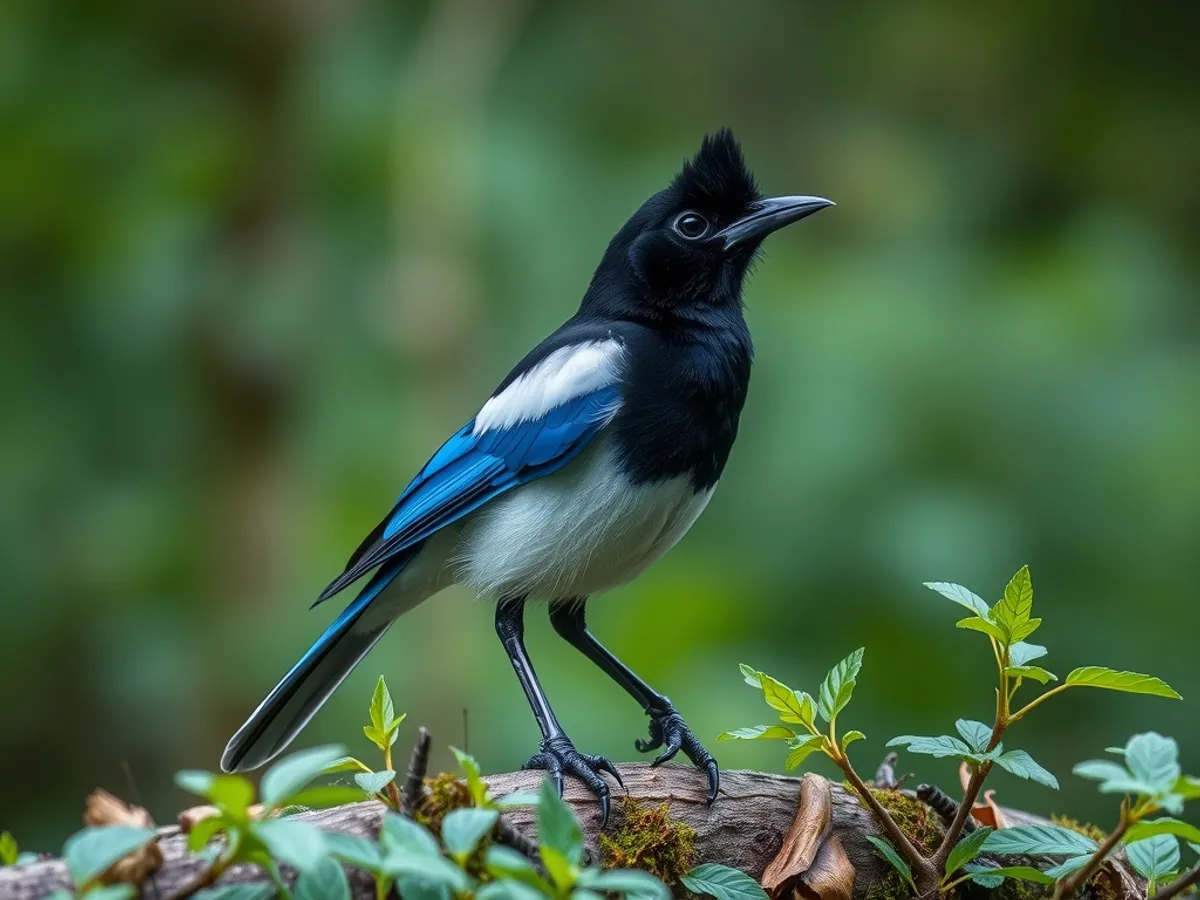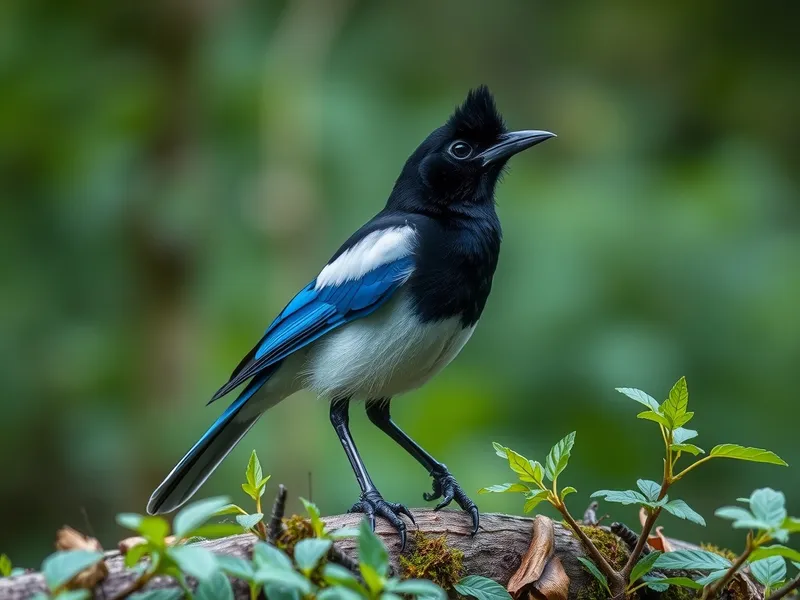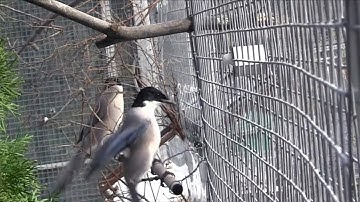
Azure-winged Magpie
Cyanopica cyanus

Meet the Azure-winged Magpie
The Azure-winged Magpie is a striking medium-sized bird known for its soft blue wings and tail, contrasted by a pale grayish body and a black cap. These highly social birds are often found in noisy, cooperative flocks, foraging on the ground or in trees for a variety of foods. Native to East Asia and the Iberian Peninsula, they inhabit woodlands, parks, and gardens. Their intelligence and adaptability help them thrive in both rural and urban environments. Azure-winged Magpies are also known for their complex vocalizations and communal breeding behaviors.
Classification
Bird
Habitat
Open woodlands and forest edges
Diet
Omnivore
Lifespan
7-15 years
Conservation
Least Concern
Weight
65-76 grams
📖Fascinating Facts
Striking Plumage
Their azure-blue wings and tail feathers make them one of the most visually distinctive members of the crow family.
Cooperative Breeders
Azure-winged Magpies often live in groups where non-breeding adults help raise chicks in communal nests.
Flexible Diet
They eat a varied diet of insects, seeds, berries, and sometimes even small reptiles or bird eggs, adapting to seasonal food availability.
📋Detailed Description
The Azure-winged Magpie (Cyanopica cyanus) is a medium-sized corvid, measuring 31–35 cm in length, with a wingspan of approximately 32–38 cm and a weight ranging from 65 to 76 grams. Its most distinctive features are the vivid azure-blue coloration of its wings and long tail, which contrast sharply with its soft, pale greyish-white underparts and back. The head is capped in glossy black, extending down to the nape, while the bill and legs are slender and black, giving the bird a delicate appearance compared to other magpies. The species exhibits a streamlined body and relatively small bill, adaptations that facilitate agile foraging in dense foliage. Azure-winged Magpies are highly social, forming flocks that can number from a few individuals to over 70, particularly outside the breeding season. Their vocalizations are complex, including a variety of harsh calls, chatters, and whistles used for communication and coordination within flocks. These birds are both arboreal and terrestrial, foraging in trees as well as on the ground. Their intelligence is notable, with problem-solving abilities and cooperative behaviors observed in both wild and captive settings. The species is widely distributed across East Asia (China, Korea, Japan, Mongolia) and the Iberian Peninsula, where it occupies a range of wooded habitats, including mixed forests, pine plantations, parks, and suburban gardens.
💡 Did you know?
Despite their disjunct populations in East Asia and Iberia, genetic studies have revealed they are two distinct species, once thought to be the same.
🔬Research & Sources
Wikipedia Summary
The azure-winged magpie is a bird in the crow family. It is 31–35 cm long and similar in overall shape to the Eurasian magpie but is more slender with proportionately smaller legs and bill. It belongs to the genus Cyanopica.
Last Modified: 6/2/2025
🎭Behavior & Social Structure
Azure-winged Magpies are diurnal and exhibit pronounced sociality, often engaging in cooperative foraging and sentinel behaviors. Flocks move together through their habitat, with individuals taking turns watching for predators while others feed. Their diet is omnivorous and seasonally variable, consisting of insects, caterpillars, spiders, berries, seeds, acorns, and occasionally small vertebrates or eggs. They are known to cache food in the ground or under leaf litter for later consumption. Foraging is typically done in loose groups, with birds communicating constantly through a repertoire of calls. During the breeding season, social structure becomes more complex, with cooperative breeding observed—non-breeding individuals may help raise the young of dominant pairs. Roosting is communal, with flocks gathering in dense foliage or bamboo thickets at night. Territorial aggression is minimal outside the immediate vicinity of nests.
👶Reproduction & Life Cycle
Breeding occurs from late April to July, varying with latitude and local climate. Azure-winged Magpies are socially monogamous, but cooperative breeding is common, with up to five helpers assisting a breeding pair. Nests are constructed in trees or tall shrubs, typically 2–10 meters above ground, and are built from twigs, roots, and lined with softer materials. Clutch size ranges from 5 to 9 eggs, which are pale greenish or bluish with brown speckles. Incubation lasts 15–17 days, primarily by the female, while the male and helpers provide food. Both parents and helpers feed the chicks, which fledge at about 16–19 days old. High reproductive success is attributed to cooperative care and predator vigilance.
🛡️Adaptations & Survival
Azure-winged Magpies possess several adaptations for survival in diverse environments. Their slender, elongated wings and tail enable agile flight and maneuverability in dense woodlands. The species' social structure and cooperative breeding enhance reproductive success and predator avoidance. Their omnivorous, opportunistic diet allows them to exploit a wide range of food resources, while their ability to cache food provides resilience against seasonal shortages. Complex vocalizations facilitate coordination within large flocks and may play a role in mate selection and territory defense. Behavioral flexibility and intelligence have enabled the species to thrive in both natural and human-modified landscapes.
🎨Cultural Significance
In East Asian cultures, especially in China and Korea, the Azure-winged Magpie is regarded as a symbol of good fortune, happiness, and fidelity. It appears in folklore, art, and literature, often associated with positive omens or as a messenger between lovers, as in the Chinese Qixi Festival legend. In the Iberian Peninsula, the species is less prominent in folklore but is recognized as a charismatic component of local avifauna. Its striking appearance and social behavior have made it a subject of interest for birdwatchers and naturalists.
🔬Recent Research & Discoveries
Recent genetic studies have clarified the taxonomy of the Azure-winged Magpie, revealing that the East Asian and Iberian populations are distinct species (C. cyanus and C. cooki, respectively), having diverged over one million years ago. Ongoing research focuses on the evolution of cooperative breeding, vocal communication, and cognitive abilities within the genus Cyanopica. Studies of urban populations are shedding light on behavioral plasticity and adaptation to anthropogenic environments. The species is also used as a model for understanding the ecological impacts of habitat fragmentation and climate change on social birds.
🎥Wildlife Videos

Discovering the Enigmatic Azure-Winged Magpie 🐦🎶🐦
Embark on a journey to uncover the mysteries of the stunning Azure-Winged Magpie! With its vibrant blue plumage and striking ...
Cute Animals

11 Breeding Helpers
The azure-winged magpie is a very social bird. In addition to always traveling in flocks, some members help others to feed their ...
Alberto Redondo Documentales

Iberian Magpie
Copyright © Marek Jackowski, 2019 - 2025. All Rights Reserved.
Marek Jackowski Photography

Azure-winged Magpie Eating the fruit | Cam Nature | Cute Magpie | Are the fruits taste good?
Azure-winged Magpie Eating the fruit | Cam Nature | Cute Magpie | Are the fruits taste good? Cute bird eat yellow fruits. We film ...
Cam Nature

What Makes the Azure-Winged Magpie So Special?
Learn all about ornithologial puzzle that is the Azure-Winged Magpiel in this informative video. You'll discover why these birds are ...
Dusty Gedge

Azure-winged magpies cooperate to get food
Researchers investigated prosociality in the cooperatively breeding corvid Cyanopica cyana (Azure-winged magpie) and ...
SciNews
🌍Habitat Information
The Azure-winged Magpie typically inhabits Open woodlands and forest edges environments. Azure-winged Magpies have adapted to their environments with specialized features and behaviors.
Primary Habitat:
Open woodlands and forest edges
More detailed habitat information will be available soon.
🛡️Conservation Status
The Azure-winged Magpie is currently classified as Least Concern. Conservation efforts are crucial for preserving this species for future generations.
Common Threats:
- 🏠Habitat loss and fragmentation
- 🌡️Climate change impacts
- 🎯Hunting and poaching
- 🏭Human-wildlife conflict
⚠️Threats & Conservation Challenges
Currently assessed as Least Concern by the IUCN, Azure-winged Magpies have stable and, in some regions, expanding populations. However, localized threats include habitat loss due to urbanization, agricultural intensification, and deforestation. In some areas, persecution as an agricultural pest or nest predation by corvids and mammals can impact breeding success. Climate change may alter habitat suitability and food availability in the future. Despite these challenges, the species' adaptability and broad diet buffer it against severe declines.
🔬Scientific Classification
Scientific Name
Cyanopica cyanus
Classification Hierarchy
🔍 About Taxonomic Classification
Taxonomic classification is a hierarchical system used by scientists to classify and organize living organisms based on shared characteristics and evolutionary relationships.
The system moves from broad categories (Kingdom) to increasingly specific ones, with each animal's scientific name typically consisting of its Genus and species.
📝Community Notes
Share your observations and insights about the Azure-winged Magpie with our community of wildlife enthusiasts.
Join Our Community
Sign in to share your observations and connect with fellow wildlife enthusiasts.
Sign In to ContributeNo community notes yet
Be the first to share your observations about the Azure-winged Magpie!
Explore Azure-winged Magpie
Select a tab above to learn more about this amazing animal.
📸Photo Gallery
No photos available for this animal yet.
🌟Discover More Wildlife
Continue your journey of discovery with more fascinating animals from our database
